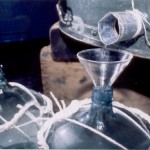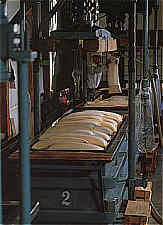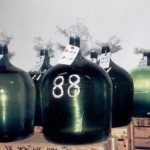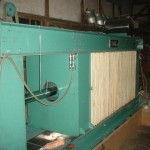What is “Arabashiri” Sake? It is a term we can see on labels of sake, but is actually independent of the grade of sake itself. Let’s see what it really means.
After a tank of “moromi” (fermenting mash) has run its course, it is ready to be pressed  through a mesh to allow the clear or slightly amber sake to pass through, while the lees, the rice solids that did not or could not ferment, are retained behind. As alluded to in the article above, this “squeezing” or “pressing” step is known as “shibori” in Japanese, and there are several ways of doing it, each with its own attendant degree of labor intensiveness and resulting quality of sake product.
through a mesh to allow the clear or slightly amber sake to pass through, while the lees, the rice solids that did not or could not ferment, are retained behind. As alluded to in the article above, this “squeezing” or “pressing” step is known as “shibori” in Japanese, and there are several ways of doing it, each with its own attendant degree of labor intensiveness and resulting quality of sake product.
While most sake today is pressed using a large machine that does a more than adequate  job, historically and traditionally sake was pressed using a simple box known as a fune that has a hole and short trough at one end on the bottom. Most fune are perhaps a meter wide, three long and two deep, and made of a non-aromatic wood like cherry or paulownia, although today many are also made of steel, or even concrete. When the mash is deemed ready to be pressed, it is poured into meter-long cotton bags holding about 10 liters each, which are then laid down in an orderly fashion into the wooden fune. The sake is then squeezed out as a lid is cranked down into the box. This process will lead to slightly noticeably better sake than a machine pressed sake, but at a price: it takes perhaps three times the time and manpower to press sake using a fune.
job, historically and traditionally sake was pressed using a simple box known as a fune that has a hole and short trough at one end on the bottom. Most fune are perhaps a meter wide, three long and two deep, and made of a non-aromatic wood like cherry or paulownia, although today many are also made of steel, or even concrete. When the mash is deemed ready to be pressed, it is poured into meter-long cotton bags holding about 10 liters each, which are then laid down in an orderly fashion into the wooden fune. The sake is then squeezed out as a lid is cranked down into the box. This process will lead to slightly noticeably better sake than a machine pressed sake, but at a price: it takes perhaps three times the time and manpower to press sake using a fune.
However: at first, when the moromi-laden cloth bags are laid into the fune, for a while, the sake will run out of its own accord, under only the weight of the bags, with no need to crank the lid down into the box yet. This free-run fresh sake is known as “arabashiri,” which means “rough run.”
And slightly rough it is, in a brash and appealing kind of way. So appealing is it that many brewers market sake with the term arabashiri on the label, and it is quite likely you will come across it from time to time.
After the arabashiri trickles to a halt, the sake is squeezed out with pressure from the lid. This sake, known as “naka-dare,” “naka-dori” or even “naka-gumi” and is generally the most prized of the lot. After this long step, the bags are pulled out, rearranged in the box, and the lid is again cranked down to get the last few drops. This final bit of sake is known as “seme,” and amounts to only about five percent of the batch. No one would market their “seme,” but rather it will likely be mixed into other, lower grade sake.
Another interesting practice employed when pressing sake this way is to separate the sake  as it comes out of the hole at the bottom of the fune into separate traditional sized 18 liter bottles, known as “ittou-bin.” The sake in each of these bottles will be slightly different in aroma and flavor. Often, these will be handled slightly differently, and the best of the best will be, for example, submitted to tasting contests.
as it comes out of the hole at the bottom of the fune into separate traditional sized 18 liter bottles, known as “ittou-bin.” The sake in each of these bottles will be slightly different in aroma and flavor. Often, these will be handled slightly differently, and the best of the best will be, for example, submitted to tasting contests.
There is an important note to remember with these terms: they are not legally defined definitions or even industry standards. That means that they way they are used can and does vary from place to place. So an “arabashiri” does not absolutely have to be a sake that was pressed using the fune box-pressing method. It can be any sake that a brewer wanted to call arabashiri, maybe for the rough-and-ready feel that the term has. So it can, in fact, apply to a drip-pressed sake or even a machine-pressed sake.
definitions or even industry standards. That means that they way they are used can and does vary from place to place. So an “arabashiri” does not absolutely have to be a sake that was pressed using the fune box-pressing method. It can be any sake that a brewer wanted to call arabashiri, maybe for the rough-and-ready feel that the term has. So it can, in fact, apply to a drip-pressed sake or even a machine-pressed sake.
This lack of legally defined officialdom applies to the middle-pressing terms as well, which should not be surprising, seeing as there are three of them used more or less interchangeably.
But in general, arabashiri refers to the free-run sake that runs out under its own weight when sake is pressed using a fune. Just remember that there will be some vagueness and some exceptions!




